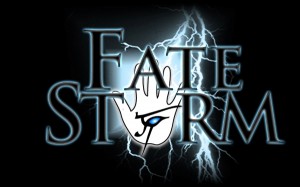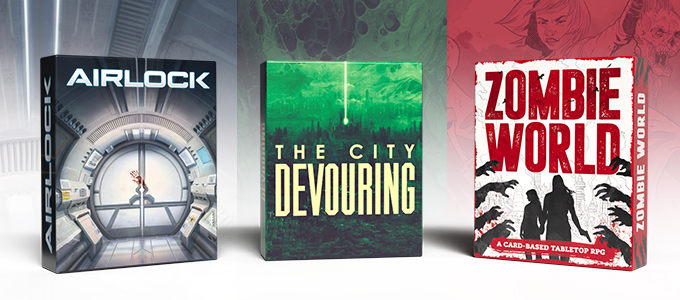Shattered Moon – How it Looks (Part 2)
By Aaron T. Huss
 Welcome to Part 2 of the Featured Product series for Shattered Moon and FateStorm. Part 2, How it Looks, takes a look at the layout, formatting, artwork, and accessories of both.
Welcome to Part 2 of the Featured Product series for Shattered Moon and FateStorm. Part 2, How it Looks, takes a look at the layout, formatting, artwork, and accessories of both.
ARTWORK
One thing can be sure, both Rogue Marshal and Shattered Moon have very intriguing covers. Although you may not like the digital look or the rough style, the scene being depicted is alluring and brings you in to see what the book has inside. The writer, Tim Westhaven, happens to be the artist for these books as well. His style is a little rough and many of his pieces are digital, but it’s better than some artwork I’ve seen and always does a good job of capturing the right appeal to what the content is providing.
To say that I wasn’t immediately intrigued by the cover artwork would be a lie. In fact, it was the cover artwork that drew me in to do a Featured Product series on these books. That’s quite an effect. The cover artwork for Shattered Moon easily depicts the fantasy races available, although I can’t really say it does a great job of representing the darkness of the setting. You instead get the mash-up for fantasy and what could be a higher fantasy technology, both prominent features within the setting.
So what about inside the book? The artwork inside the book is a lot like what you see on the cover. There is an excellent amount of synergy between all the artwork and the book feels very whole.
LAYOUT & FORMATTING
To start, the layout and formatting of Rogue Marshal was one of the reasons I struggled to grasp its concepts. A lot of content wasn’t ideally presented, but I was glad to see this was remedied within Shattered Moon. There’s no doubt that Shattered Moon is a great look book (although excessively cumbersome for reading on a handheld device). It has a great and very usable layout, the formatting is superior to Rogue Marshal, and the trade dress looks excellent. From a presentation standpoint, Shattered Moon is very professional, even though you have to overlook a couple “gotchas” here and there, common when dealing with indie publishers who can’t afford to hire out a graphic designer.
The layout and formatting of Shattered Moon are one of its strong points that help in presenting the mechanics of FateStorm. Because of its advanced nature, the system requires a lot of detail and much time will be spent reading and rereading its content. Although the bookmarks were not completely ideal, it was easy for me to pick-out the sections I needed to return to when grinding my way through the FateStorm system description.
ACCESSORIES
The FateStorm system has a couple accessories to aid in gameplay. One is the obvious character sheet, the other is the Fate Deck, a set of playing cards meant to add randomness into gameplay and character creation. To start with the character sheet: I don’t like it. For one thing, there is a lot of that goes into creating a character, and this particular character sheet attempts to squeeze all of that into a single page. Not a front and back page, just one page. I found this extremely difficult in terms of writing small, and quickly running out of space. This definitely needs to be expanded to two pages to allow proper space for things like full equipment listing instead of some abridged entry using shorthand.
The second accessory is the Fate Deck, the only piece of randomness the FateStorm system has. This set of playing cards has symbols and trait numbers that have different meanings depending on whether they’re used for character creation (and depending on what part of character creation they’re being used for), or during gameplay. This means that the meaning of each card is defined multiple times throughout the book depending on when the cards are being used. I don’t really like this, but I understand why it’s done. It should be noted there are only 22 cards and they don’t have a rear, only a front (the cards are included for printing in the book). Any game that requires the use of cards or has them as a prominent feature should use a full deck. There’s no reason why there can’t be 52 cards. Additionally, for proper playing card design, there should be a front and a rear; otherwise printing them is awkward and the cards don’t look as nice on the tabletop.
I understand their use, but the execution could be drastically improved on.
THE MEAT
The driving force behind any tabletop role-playing game is player characters. Without player characters, you simply reading a book and watching the events take place. So how do characters look within Shattered Moon? Although there are a fair number of options, when I was creating characters, I was completely unable to create the character I had designed in my head.
FateStorm uses a type of character class, although not exactly the character class style you’re used to. It’s more of a tree-styled character class system whereas you have to have a particular lower class if you desire a character with a particular higher class. This is not a system I prefer, and it meant I could not create the characters I really wanted to.
To add to this, I had a really difficult time wrapping my arms around some of the FateStorm mechanics, but this could be my misunderstanding as much as it is the system not being fully explained in specific areas. Does this equate to a poorly designed system? Absolutely not! This just means that the style of gameplay I prefer is not conducive to the FateStorm system. It does not mean everyone else will find think the same way, especially for those who like to role-play some of the basic archetypes within fantasy games. I prefer a lot more flexibility in character creation, but not everyone does.
However, one thing to be very aware of is that there are not very many base classes and each advanced class is a branch off a base class. Thus, you cannot simply become one of those advanced classes, you must play your way up to it.

